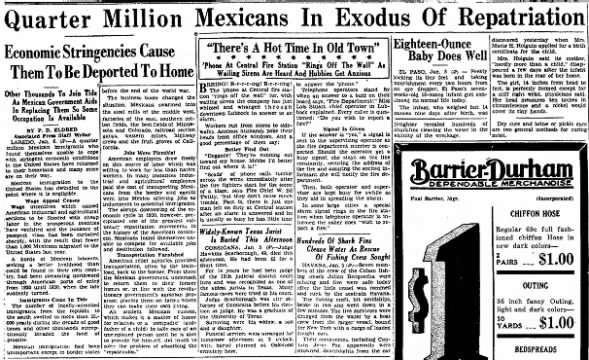- Headline
-
Quarter Million Mexicans In Exodus Of Repatriation
- Sub-Headline
- Economic Stringencies Cause Them To Be Deported To Home
- Publication Date
- Sunday, January 6, 1935
- Historical Event
-
“Repatriation” of Mexican Americans and Mexican nationals continues
This database includes 249 articles about this event - Article Type
- Newspaper
- Page Section and Number
- 18
- Author/Byline
- P.D. Eldred (AP)
- Article Text
- LAREDO, Jan. 6, (AP)—A quarter million Mexican immigrants who themselves unable cope with stringent economic conditions in the United States have returned to their homeland and many more are on their way.
Mexican immigration to the United States has dwindled to the point where it is negligible.
Wage Appeal Ceases
Wage incentives which caused American industrial and agricultural sections to be flooded with cheap labor in the prosperous twenties have vanished and the issuance of passport visas has been curtailed sharply, with the result that fewer than 1,000 Mexicans migrated to the United States last year.
A horde of Mexican laborers, seeking a better livelihood than could be found in their own country, had been streaming northward through American ports of entry from 1920 until 1930, when the tide suddenly turned.
Immigrants Come In Tide
The number of legally-admitted, immigrants from the republic to the south swelled to more than 25,000 yearly during the decade of good times and other thousands surreptitiously invaded the land of promise.
Mexican immigration had been unimportant except in border states before the end of the world war.
The business boom changed the situation. Mexicans swarmed into the steel mills of the middle west, factories of the east, southern cotton fields, the beet fields of Minnesota and Colorado, section gangs, western mines, highway railroad crews and the fruit groves of Callfornia.
Jobs Were Plentiful
American employers drew freely on this source of labor which was willing to work for less than native workers. In many instances industrial and agricultural employers paid the cost of transporting Mexicans from the border and agents went into Mexico offering jobs. as inducement to potential immigrants.
The abrupt downswing of the economic cycle in 1930, however, precipitated one of greatest voluntary repatriation movements in the history of the American continent. Mexicans found themselves unable to compete for available jobs and destitution followed.
Transportation Furnished
American relief agencies provided transportation, often by the trainload, back to the border. From there the government undertook to them to their former Mexican, homes or in line with the revolutionary government's agrarian program. placing them on farms where they can make their own living.
An ancient Mexican custom, which makes it a matter of honor for relatives or a "compadre" (godfather of a child) to take care of an unemployed person until he is able to provide for himself, did much 10 solve the problem of absorbing the "repatrindos." - History Unfolded Contributor
- Lael F.
- Location of Research
- Newspapers.com (https://www.newspapers.com)
Learn More about this Historical Event: “Repatriation” of Mexican Americans and Mexican nationals continues
- Anthony Acevedo, a Mexican-American deportee, and US Army medic held POW at Berga (Americans and the Holocaust online exhibition)
- America’s Forgotten History of Mexican-American ‘Repatriation’ (NPR interview with Francisco Balderrama)
- Mexican Americans and Repatriation (Texas State Historical Association)
- Aqui Estamos y No Nos Vamos / Fighting Mexican Removal Since the 1930s (Boyle Heights Museum)
- INS Records for 1930s Mexican Repatriation (U.S. Citizenship and Immigration Services)
- Texas’ Mass Mexican Deportation (Think; KERA interview with Melita M. Garza)

Download the full newspaper page
See full image on newspapers.com
Newspaper images provided by Newspapers.com
